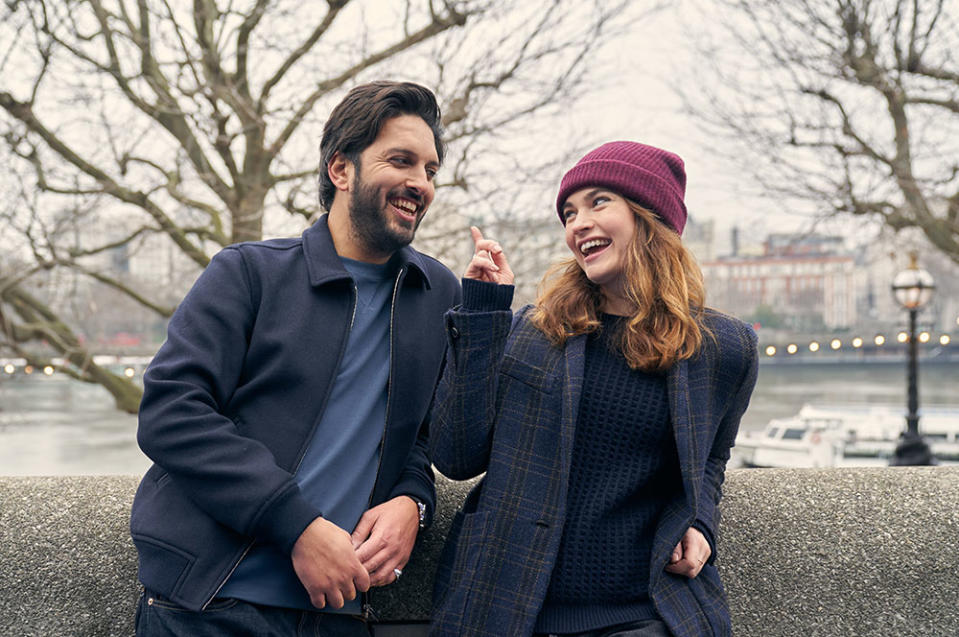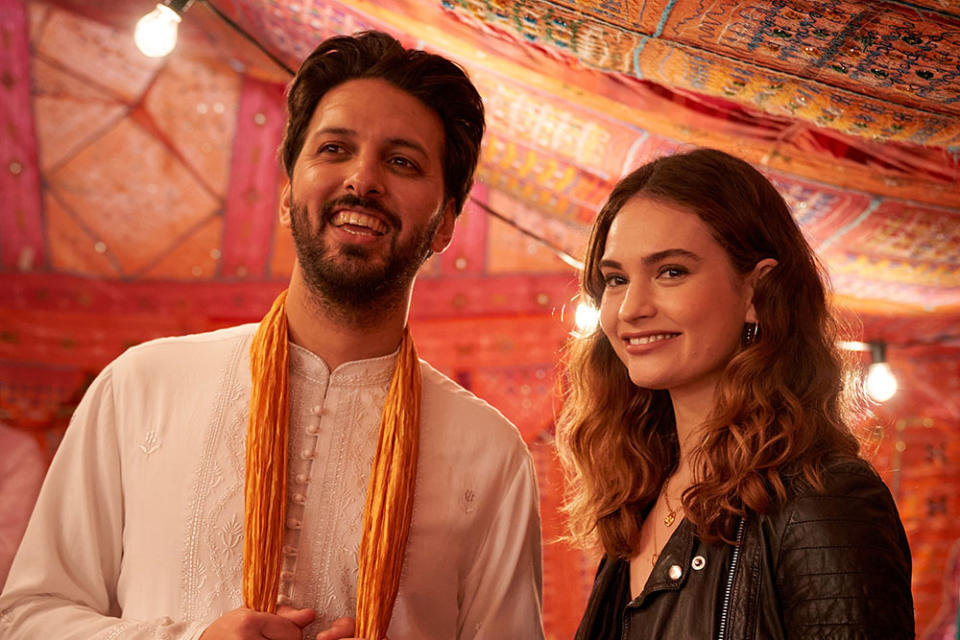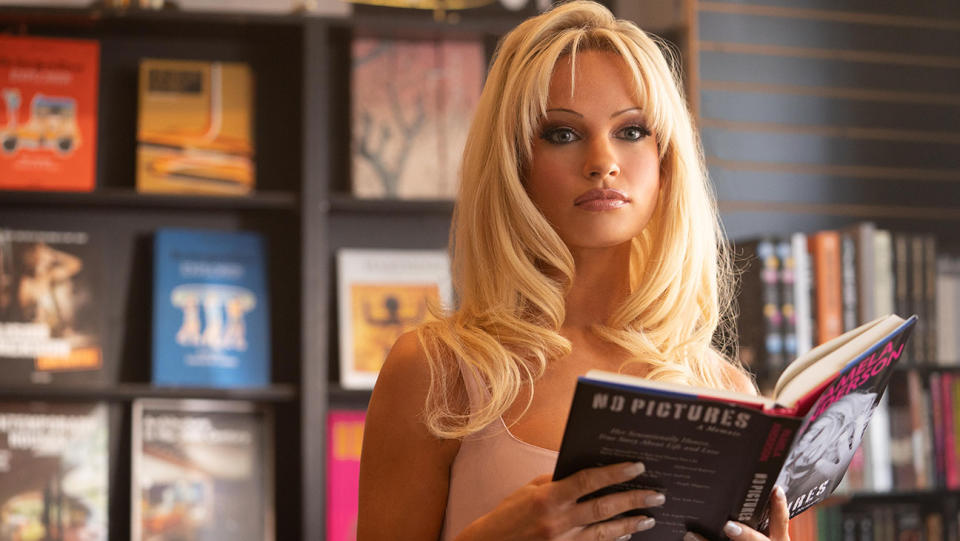‘What’s Love Got to Do With It?’ Star Lily James Talks the Rom-Com’s ‘Cinderella’ Scene and Showing Off Her Table Tennis Skills
- Oops!Something went wrong.Please try again later.
- Oops!Something went wrong.Please try again later.
- Oops!Something went wrong.Please try again later.
- Oops!Something went wrong.Please try again later.

Shortly before Lily James spent four hours a day transforming into Pamela Anderson for Pam & Tommy, she got back into the swing of things, post-Covid shutdown, by way of What’s Love Got to Do with It?, a London and Lahore-set romantic comedy. Filming mostly took place in James’ own backyard of London, and her co-lead, Shazad Latif, happened to be a longtime friend and former flatmate. So, in hindsight, What’s Love was likely the perfect amount of normal before the whirlwind of Pam & Tommy.
Written by Jemima Khan and directed by Shekhar Kapur, the film centers on Zoe (James), a documentarian who decides to chronicle her childhood friend Kaz’s (Latif) arranged marriage, from the first Skype call with his bride-to-be, to their first time meeting in Lahore, Pakistan. And through the documenting of Kaz’s “assisted” marriage, Zoe begins to take stock of her own dating pitfalls and acknowledge her feelings for Kaz.
More from The Hollywood Reporter
Golden Globes: The Best-Dressed Stars and All the Fashion Details
A Huge Pearl Sculpture Sparkles Inside the New Chanel Flagship on Rodeo Drive
The film also includes a modern fairy tale device where Zoe tells her nieces (Grace and Lolly Askew) classic bedtime stories that parallel her own dating life (until they don’t) through the use of montage. And one of the retellings involves Cinderella, who James famously brought to life in Kenneth Branagh’s well-received live-action reimagining, Cinderella (2015). Naturally, James was apprehensive about the meta moment at first.
“You’re pretty much the first person that’s brought that up, which is really surreal. I thought everyone would. I guess I’m a real has-been when it comes to Disney Princesses,” James tells The Hollywood Reporter. “But it was in the script, and I couldn’t decide if it was the corniest, worst thing in the world or actually quite hilarious. But I thought it was fun to turn those fairy tales on their head … I was laughing at it inside. The irony.”
The film also gave James the chance to make her brothers proud, as she has a dialogue scene while playing table tennis. She became fiercely competitive at table tennis thanks to playing against her brothers for years and years, and she eventually traded forehands and backhands with Latif during pub games in the early days of their decade-plus-long friendship.
“I couldn’t wait for my two brothers to watch it because I knew this would be my reigning moment in their eyes. And it was!” James says. “I am a deeply competitive human being when it comes to table tennis. During rehearsals, there was actually a ping-pong table at Working Title. So Shaz and I were playing, and Shekhar [Kapur] walked in and was like, ‘Huh. This is kind of cool. We should do a scene where you are playing table tennis.’ So it made the scene way better than it would’ve been.”
Below, during a recent interview with THR, James also discusses how she passed the time during Pam & Tommy’s four-hour hair and makeup sessions.
So where did What’s Love Got to Do with It? fall on your timeline?
So this came at an interesting moment in life where we were mid-lockdown. I was locked in my house and unsure whether I’d get out again. And then this script came along with an email that contained this magical information that my great friend Shazad Latif was attached. I’ve known him for the last ten or twelve years; I used to sleep at the end of his bed on a mattress in his flat in Tufnell Park. (Laughs.) So we are great friends, and it was just a gift to be able to dream about going to work again, let alone alongside one of my best friends. Working Title, who I’ve made several films with, was also producing it. And I really found Jemima Khan’s script to be totally unique and such an honest, nonjudgmental look at culture, while celebrating a multicultural Britain and being a love letter to Pakistan. Everything came from her own experience, and so I was hook, line and sinker with this one.

So when you first started reading this script, what qualities of Zoe did you find most actable?
When you find any character, the similarities and even the differences are just as useful, but the way that you can infuse the character with yourself and your own experience is always really personal. And I like to bring myself to every character as much as I can and to be as vulnerable as possible. And with Zoe, it wasn’t so much of a stretch. It felt close to my own experience growing up in London, in my late teens, early twenties, and figuring out how you balance life and love and ambition. It’s the chaos of trying to figure that out and trying to pretend you’re okay and trying to navigate your family. And motherhood. “Do you want kids?” There’s that awful biological clock that adds this pressure and is sort of doubled down by society. So I just loved this message that you need your village, your community and your people to look after you in whatever form that comes. So I just thought that was something really potent, especially given the fact we were just coming out of such a dark time of solitary living during Covid.
Zoe is a documentary filmmaker, and while the movie isn’t too process-oriented, did you still pull bits and pieces from a number of people?
Yeah, it isn’t so focused on Zoe as the filmmaker. It would’ve been great if it could have been more, but it wasn’t the film to really do that. However, I did the research, and one of the great things is that a lot of the stuff I shot on that camera is in the movie. I was always recording. I was always rolling in scenes, and it was such an amazing way to watch another character, to watch Shazad play Kaz through that lens. So, Zoe was really able to fall in love with him through that lens and that barrier. Her guard was down, and she could really look into his eyes, which she wouldn’t have done otherwise, knowing that he was on this journey of having his arranged marriage. So the camera helped with the character.
There were a few guys in the crew who I’ve done several movies with. One guy, in particular, Julian [Bucknall], was the focus puller, and I’ve done Darkest Hour and Mama Mia with him. So he was always giving me little tips/teasing me, and everyone in the crew was helping me out with the filming. There were a couple of different documentary filmmakers that were there, and on the days I was doing heavy filming, they would guide me and help me with the technical side. So it was fun being behind the lens. I’ve always thought that I want to direct at some point, so it was nice having that visual aspect and telling the story through the image.
So you probably knew this was coming, but was Zoe’s Cinderella bedtime story already in the movie when you signed on? Or did they make the case to you later?
(Laughs.) It was already in the movie! But do you know what? You’re pretty much the first person that’s brought that up, which is really surreal. I thought everyone would. (Laughs.) I guess I’m a real has-been when it comes to Disney Princesses. But it was in the script, and I couldn’t decide if it was the corniest, worst thing in the world or actually quite hilarious. But I thought it was fun to turn those fairy tales on their head and lose a bit of reverence and enjoy this modern retelling. It was right at the start of the shoot, and those two little girls were so adorable. We had such a fun time. But yeah, I was laughing at it inside. (Laughs.) The irony.
The two young actors (Grace and Lolly Askew) who played Zoe’s nieces, did they know right away that they were dealing with Cinderella herself?
Yeah, they knew for sure. (Laughs.) They were so cool, and they spent the whole time rapping Hamilton. They knew every single word, so it was a pretty great moment.
So you’ve clearly played ping-pong before, but I can’t imagine you’ve ever had a dialogue scene while playing in the winds of London. Were you proud of your multitasking skills that day?
I’ve never been more proud, and I couldn’t wait for my two brothers to watch it because I knew this would be my reigning moment in their eyes. And it was! I am a deeply competitive human being when it comes to table tennis. I grew up playing it with my brothers, but I’ve never beaten them, which is just painful to admit. (Laughs.) Shaz and I used to play a lot together in a pub near Angel of Rosebery Avenue, and during rehearsals, there was actually a ping-pong table at Working Title. So Shaz and I were playing, and Shekhar [Kapur] walked in and was like, “Huh. This is kind of cool. We should do a scene where you are playing table tennis.” So it came about really naturally, and it’s always great to distract yourself from acting. So the table tennis really did that, and it made the scene way better than it would’ve been. (Laughs.)
Zoe makes a snap judgment in regard to arranged marriage. She half-jokingly likens it to Stockholm syndrome, but there’s a reason why she second-guesses Kaz’s cultural tradition. So where did you end up on the subject? Were you able to give it a fair shake to some degree?
Yeah, I really was. I was able to learn so much about arranged marriages, and in general, I just like exploring other cultures and seeing everything you can learn and gain. Millions of people have arranged marriages across the world that are extremely successful, and this film really highlights and celebrates the differences between Eastern and Western culture, in a way that feels totally nonjudgmental and truthful. That was incredibly important to Jemima. The amount of test screening she did, showing it to different audiences of all different ages, she really wanted to make sure that it reflected people’s own experience and lives. Of course, you can’t do that entirely, and this is just one look at arranged marriages through this gaze of exploring love in a nonjudgmental but celebratory way. So it’s just one angle, but I think that we explored it with a sense of curiosity. And I found that really enlightening.

At the premiere of Zoe’s documentary, her subjects respond to her choices in a variety of ways, both good and bad, and you certainly know what that feeling is like for the people on the screen. You leave your performances in the hands of a director and an editor until they present it a year later at the premiere. So, in general, how often are you surprised by the choices they make?
Well, the great thing is I don’t read reviews, so I have absolutely no idea what people have said about this movie, and I can say that hand on heart. (Laughs.) So that’s probably a good thing. But with regards to how your choices appear on screen, that’s actually extremely difficult because you have no control as an actor. You often feel really disenfranchised from the editing and the process of when a film comes into fruition. It all happens in the edit, and it’s not just the take-to-take performance. I like to try and give a variation, which is how I know how to do it, but then you are laying yourself at the mercy of a directorial choice even more.
However, in this film, Jemima was really keen to involve me, particularly from a character perspective. She really included me, so I didn’t feel like that on this job at all. Of course, when it comes down to the final tone and all of that, that really is the job of the director. But I felt very included by Jemima, and it’s made me want to make sure that that’s always the case moving forward, that you do have a say and a voice, if you want to. Some actors just like to turn up and do it, and then never watch the movie. But I feel so connected and passionate about the roles I’ve played that I find it very hard to let go.
Yeah, some actors are afraid that they’ll over-analyze the choices that the editor or director made, and then they’ll start making their future choices based on someone else’s past choices. So it’s complicated.
Yeah, it is really complicated because the last thing you want is to have a third eye on yourself as you’re acting. You obviously want to appreciate craft and understand where the camera is so that you can give the best performance, but at the end of the day, you just want to jump off the cliff’s edge and be in the moment. When you control a moment or you’re judging yourself, you’re killing it. So it is super tricky, and I don’t know quite what the balance is yet. It’s really hard. Maybe it varies movie to movie and how much you trust a director and everyone involved. So it all comes down to trust.

So, in 2021, when you spent half your life in a hair and makeup trailer for Pam & Tommy, how would you pass the time? Did you run lines in your head? Listen to podcasts? Zone out for two hours? What does one do?
(Laughs.) It’s so funny. I would have loved to have counted the amount of days I spent in the makeup trailer. It probably was half the year. With that job, I had a video reel of almost every interview Pamela Anderson has ever done, and so I learned them all by heart. I could parrot along. I also listened to ‘90s music to get myself in the zone. I really had an amazing hair and makeup team. Honestly, it was like a long meditation before work. It was four hours, but I almost wouldn’t have been able to do the day without it. So, strangely, I was fine with it, but I was dead by the end. I was on my knees and I-never-wanna-work-again tired. (Laughs.) But luckily, that didn’t last too long. So it was all part of the experience, and I was grateful for that time. I needed it to find the character each day.
Tessa Thompson told me that she was the one who suggested you for that very particular voice role in Sorry to Bother You. Did she have to explain everything to you a couple times since it was such an unusual premise?
(Laughs.) I was like, “Wait, what?” I was totally confused but intrigued. Tessa makes such incredible choices, and she’s such a phenomenal actor and person. So I was just very flattered to be involved and to be asked. I was literally filming Mama Mia: Here We Go Again in Croatia, and then I went back and zoomed this makeshift ADR studio in my apartment in Croatia. And so I did this session where I was talking along to that incredible performance she gave, and yeah, it was really cool.
***
What’s Love Got to Do with It? is available in theaters on May 5. This interview was edited for length and clarity.
Best of The Hollywood Reporter
'The Super Mario Bros. Movie': See Who Voices the Beloved Characters
Hollywood Reporter Critics Pick the 50 Best Films of the 21st Century (So Far)
Hollywood Flashback: 'Soylent Green' Depicted an Overpopulated Planet With a Dark Secret

